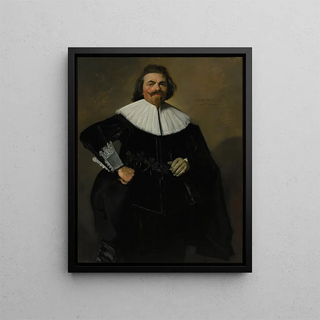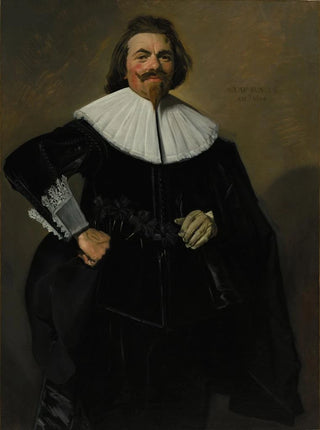Painting Portrait of Tieleman Coq - Frans Hals | Art print


View from behind

Frame (optional)
In the fascinating world of 17th-century Dutch painting, the "Art print of Tieleman Coq" by Frans Hals stands out for its intensity and depth. This painting, which captures the very essence of its subject, is a true window into an era when portrait art reached new heights. The depiction of Tieleman Coq, a man of his time, evokes not only a unique personality but also a vibrant atmosphere of Dutch society. Through this work, the viewer is transported into a universe where emotions and nuances of character blend with rare elegance, inviting everyone to explore the subtleties of the human soul.
Style and uniqueness of the work
Frans Hals's style is immediately recognizable, marked by bold and expressive brushwork. In the "Art print of Tieleman Coq," the artist uses quick brushstrokes to create a lively and dynamic texture, infusing a sense of movement into the piece. The colors, though rich and varied, are applied with a lightness that allows light to play on the surfaces, emphasizing facial features and clothing details. This portrait stands out for its ability to capture not only the physical appearance of Tieleman Coq but also his character and social status. The facial expression, both serious and contemplative, reveals psychological depth that transcends mere visual rendering, making the work profoundly human and accessible.
The artist and his influence
Frans Hals, born in 1582 in Antwerp, is one of the undisputed masters of Dutch baroque painting. His innovative approach to portraiture influenced many artists, both contemporaries and successors. By emphasizing the personality and individuality of his subjects, Hals paved the way for a new way of conceptualizing the portrait, away from the rigid conventions of his time. He knew how to capture fleeting moments of life, transforming each painting into a rich and evocative visual narrative. His influence is felt in the works of many painters, notably Rembrandt, who also explored the complexities of the human soul through the art print.

Matte finish

View from behind

Frame (optional)
In the fascinating world of 17th-century Dutch painting, the "Art print of Tieleman Coq" by Frans Hals stands out for its intensity and depth. This painting, which captures the very essence of its subject, is a true window into an era when portrait art reached new heights. The depiction of Tieleman Coq, a man of his time, evokes not only a unique personality but also a vibrant atmosphere of Dutch society. Through this work, the viewer is transported into a universe where emotions and nuances of character blend with rare elegance, inviting everyone to explore the subtleties of the human soul.
Style and uniqueness of the work
Frans Hals's style is immediately recognizable, marked by bold and expressive brushwork. In the "Art print of Tieleman Coq," the artist uses quick brushstrokes to create a lively and dynamic texture, infusing a sense of movement into the piece. The colors, though rich and varied, are applied with a lightness that allows light to play on the surfaces, emphasizing facial features and clothing details. This portrait stands out for its ability to capture not only the physical appearance of Tieleman Coq but also his character and social status. The facial expression, both serious and contemplative, reveals psychological depth that transcends mere visual rendering, making the work profoundly human and accessible.
The artist and his influence
Frans Hals, born in 1582 in Antwerp, is one of the undisputed masters of Dutch baroque painting. His innovative approach to portraiture influenced many artists, both contemporaries and successors. By emphasizing the personality and individuality of his subjects, Hals paved the way for a new way of conceptualizing the portrait, away from the rigid conventions of his time. He knew how to capture fleeting moments of life, transforming each painting into a rich and evocative visual narrative. His influence is felt in the works of many painters, notably Rembrandt, who also explored the complexities of the human soul through the art print.
12,34 €






